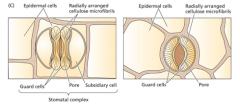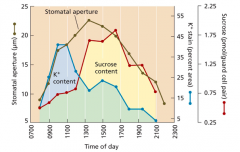![]()
![]()
![]()
Use LEFT and RIGHT arrow keys to navigate between flashcards;
Use UP and DOWN arrow keys to flip the card;
H to show hint;
A reads text to speech;
20 Cards in this Set
- Front
- Back
|
Photosynthesis is dependent on ___ and _____ exchange from the environment. How is it received? What may be a potential issue with this method? |
O2 and CO2 exchange. It is typically done through the stomata. A potential issue with using stomata for exchange is the idea that if stomata let gas in, lots of other things can get into the cells as well. |
|
|
Recall: Diffusion of gases is regulated by what factor? |
∆P. Gases will always move from regions of high ∆P to low ∆P. dQ/dt u ((D)(A)(∆Pgas)) x (Sgas) X x sqMW |
|
|
Stomata are... BONUS: how much of whatever it does is done by stomata |
Pores in the leaf surface that allow access to things (mainly gasses) from the outside to air spaces inside the leaf. (90% of gas exchange is done through stomata) |
|
|
If the stomata are open, CO2 will always flow __________. Water will always flow ___________. |
CO2 will always flow into the cell, because atmospheric partial pressure of CO2 is always higher than that within the cell. Water will always rush out! |
|
|
Stomata are located... |
On aquatic plants, on top, or else they'd drown. On plants on the ground, on the bottom. On grasses and such it's both. |
|
|
The structure of a stomata looks like... |

|
|
|
Describe the structures of monocotic and dicotic guard cells. Use the words "cellulose microfibrils", "epidermal cells". |

|
|
|
Describe the structure of stomata regularly, and then with water flowing in. |
They typically look like double doors, but when water rushes in to the cell, they swell a bit, and then end up looking like vaginal lips. |
|
|
How does water flow into the stomata in the first place?
|
Remember, water CANNOT BE ACTIVELY TRANSPORTED. In order to get water into the cell, it follows the ions that flow into the cell (they do their own thing) based on the CHANGE IN OSMOTIC PRESSURE. (You can lead a horse to water, but you can't really lead water to anything.) |
|
|
Describe the aperture of stomata during the day and explain why it all happens! |

The aperture of stomata is based on water flux, which we've already established. Water (review) only moves in response to osmotic pressure, which is adjusted by ions. So once the ions (K+ in this case) leave the cell, the water leaves too! The cell would close, but the sucrose content spikes, which actually maintains the stomata swollen. When the sucrose crashes, the stomata un-swells. |
|
|
Stomata open up when there's _______ CO2 in the cell. Stomata also open up when there's ______ light in the environment. |
???? CO2 high light! |
|
|
C3 plants and photorespiration. |
C3 plants undergo the "normal" photosynthesis pathway, and doesn't alter it in any way to stop RuBisCO from being a powerful oxygen binding substrate. Photorespiration dominates in environments with HIGH O2. |
|
|
C4 plants use ____________ separation of _______________. This is called _______________ |
Spatial, CO2, Kreb's cycle. Kranz Anatomy |
|
|
Describe "Kranz Anatomy"
|

Kranz anatomy is separating the light reactions (in the CO2 poor mesophyll cells) and the dark reactions (in the CO2 rich bundle sheath cells.
|
|
|
How does C4 photosynthesis get so much CO2 into the bundle sheath cells? |
The CO2 in the mesophyll cells are converted into carbonic acid. Now that it technically isn't CO2 anymore, it doesn't count towards the partial pressure of CO2!!
|
|
|
What kinda plants are C4 plants? |
Angiosperms! Corn, maize. C4 plants have evolved independently like 20 times. This means that it's SUPER favourable. Although not EVERY plant turns into a C4 plant because it's a very expensive process. |
|
|
CAM plants use _________ separation of CO2 and _____________. Why? |
TEMPORAL! CO2 and photosynthesis. They do this because if they open their stomata during the day, they can easily dry out. This way, however, they open up at night, when it's nice and cool.
|
|
|
CAM stands for? Why does the prof make that stupid joke every time? |
Crassulacean acid metabolism. There's "no such thing" as crassulacean acid. |
|
|
What does the Acidity of a CAM plant look like during the day? What's the reason for that?
|
The acidity of CAM plants during the day follow the curve of CO2 intake. For CAM plants, CO2 intake happens when the stomata are open (during the night.) So the acidity is highest at night. |
|
|
Aerenchyma are? Are they present in regular plants? Can they be? |
Hundreds of tiny channels that run through a cross section of plant, helping transport CO2 and O2 to the photosynthetic tissues. They are typically NOT present in "normal" plants, but they can develop in normal plants in waterlogged conditions. |

